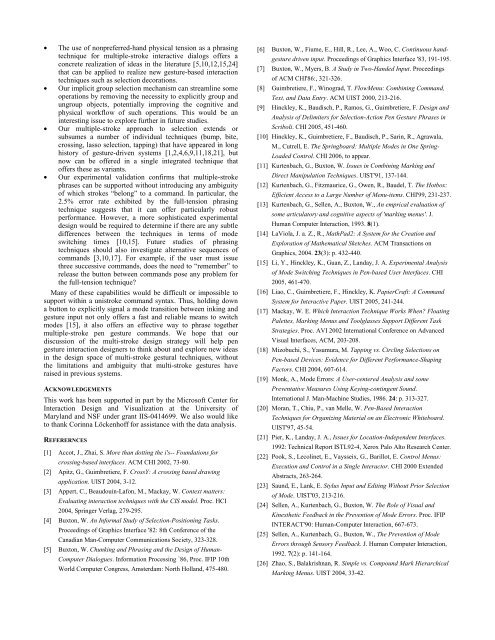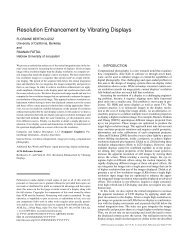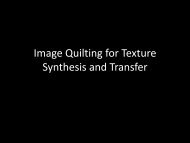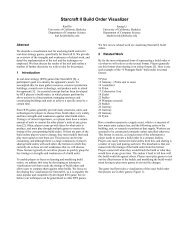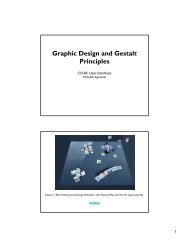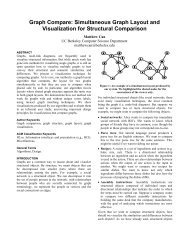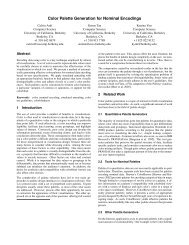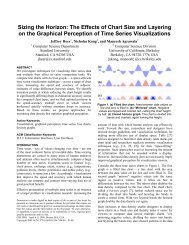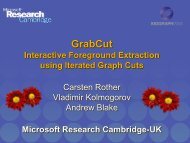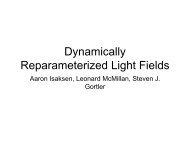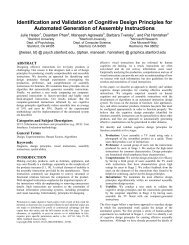Phrasing Techniques for Multi-Stroke Selection ... - Cornell University
Phrasing Techniques for Multi-Stroke Selection ... - Cornell University
Phrasing Techniques for Multi-Stroke Selection ... - Cornell University
- No tags were found...
You also want an ePaper? Increase the reach of your titles
YUMPU automatically turns print PDFs into web optimized ePapers that Google loves.
• The use of nonpreferred-hand physical tension as a phrasingtechnique <strong>for</strong> multiple-stroke interactive dialogs offers aconcrete realization of ideas in the literature [5,10,12,15,24]that can be applied to realize new gesture-based interactiontechniques such as selection decorations.• Our implicit group selection mechanism can streamline someoperations by removing the necessity to explicitly group andungroup objects, potentially improving the cognitive andphysical workflow of such operations. This would be aninteresting issue to explore further in future studies.• Our multiple-stroke approach to selection extends orsubsumes a number of individual techniques (bump, bite,crossing, lasso selection, tapping) that have appeared in longhistory of gesture-driven systems [1,2,4,6,9,11,18,21], butnow can be offered in a single integrated technique thatoffers these as variants.• Our experimental validation confirms that multiple-strokephrases can be supported without introducing any ambiguityof which strokes “belong” to a command. In particular, the2.5% error rate exhibited by the full-tension phrasingtechnique suggests that it can offer particularly robustper<strong>for</strong>mance. However, a more sophisticated experimentaldesign would be required to determine if there are any subtledifferences between the techniques in terms of modeswitching times [10,15]. Future studies of phrasingtechniques should also investigate alternative sequences ofcommands [3,10,17]. For example, if the user must issuethree successive commands, does the need to “remember” torelease the button between commands pose any problem <strong>for</strong>the full-tension technique?Many of these capabilities would be difficult or impossible tosupport within a unistroke command syntax. Thus, holding downa button to explicitly signal a mode transition between inking andgesture input not only offers a fast and reliable means to switchmodes [15], it also offers an effective way to phrase togethermultiple-stroke pen gesture commands. We hope that ourdiscussion of the multi-stroke design strategy will help pengesture interaction designers to think about and explore new ideasin the design space of multi-stroke gestural techniques, withoutthe limitations and ambiguity that multi-stroke gestures haveraised in previous systems.ACKNOWLEDGEMENTSThis work has been supported in part by the Microsoft Center <strong>for</strong>Interaction Design and Visualization at the <strong>University</strong> ofMaryland and NSF under grant IIS-0414699. We also would liketo thank Corinna Löckenhoff <strong>for</strong> assistance with the data analysis.REFERERNCES[1] Accot, J., Zhai, S. More than dotting the i's-- Foundations <strong>for</strong>crossing-based interfaces. ACM CHI 2002, 73-80.[2] Apitz, G., Guimbretiere, F. CrossY: A crossing based drawingapplication. UIST 2004, 3-12.[3] Appert, C., Beaudouin-Lafon, M., Mackay, W. Context matters:Evaluating interaction techniques with the CIS model. Proc. HCI2004, Springer Verlag, 279-295.[4] Buxton, W. An In<strong>for</strong>mal Study of <strong>Selection</strong>-Positioning Tasks.Proceedings of Graphics Interface '82: 8th Conference of theCanadian Man-Computer Communications Society, 323-328.[5] Buxton, W. Chunking and <strong>Phrasing</strong> and the Design of Human-Computer Dialogues. In<strong>for</strong>mation Processing `86, Proc. IFIP 10thWorld Computer Congress, Amsterdam: North Holland, 475-480.[6] Buxton, W., Fiume, E., Hill, R., Lee, A., Woo, C. Continuous handgesturedriven input. Proceedings of Graphics Interface '83, 191-195.[7] Buxton, W., Myers, B. A Study in Two-Handed Input. Proceedingsof ACM CHI'86:, 321-326.[8] Guimbretiere, F., Winograd, T. FlowMenu: Combining Command,Text, and Data Entry. ACM UIST 2000, 213-216.[9] Hinckley, K., Baudisch, P., Ramos, G., Guimbretiere, F. Design andAnalysis of Delimiters <strong>for</strong> <strong>Selection</strong>-Action Pen Gesture Phrases inScriboli. CHI 2005, 451-460.[10] Hinckley, K., Guimbretiere, F., Baudisch, P., Sarin, R., Agrawala,M., Cutrell, E. The Springboard: <strong>Multi</strong>ple Modes in One Spring-Loaded Control. CHI 2006, to appear.[11] Kurtenbach, G., Buxton, W. Issues in Combining Marking andDirect Manipulation <strong>Techniques</strong>. UIST'91, 137-144.[12] Kurtenbach, G., Fitzmaurice, G., Owen, R., Baudel, T. The Hotbox:Efficient Access to a Large Number of Menu-items. CHI'99, 231-237.[13] Kurtenbach, G., Sellen, A., Buxton, W., An emprical evaluation ofsome articulatory and cognitive aspects of 'marking menus'. J.Human Computer Interaction, 1993. 8(1).[14] LaViola, J. a. Z., R., MathPad2: A System <strong>for</strong> the Creation andExploration of Mathematical Sketches. ACM Transactions onGraphics, 2004. 23(3): p. 432-440.[15] Li, Y., Hinckley, K., Guan, Z., Landay, J. A. Experimental Analysisof Mode Switching <strong>Techniques</strong> in Pen-based User Interfaces. CHI2005, 461-470.[16] Liao, C., Guimbretiere, F., Hinckley, K. PapierCraft: A CommandSystem <strong>for</strong> Interactive Paper. UIST 2005, 241-244.[17] Mackay, W. E. Which Interaction Technique Works When? FloatingPalettes, Marking Menus and Toolglasses Support Different TaskStrategies. Proc. AVI 2002 International Conference on AdvancedVisual Interfaces, ACM, 203-208.[18] Mizobuchi, S., Yasumura, M. Tapping vs. Circling <strong>Selection</strong>s onPen-based Devices: Evidence <strong>for</strong> Different Per<strong>for</strong>mance-ShapingFactors. CHI 2004, 607-614.[19] Monk, A., Mode Errors: A User-centered Analysis and somePreventative Measures Using Keying-contingent Sound.International J. Man-Machine Studies, 1986. 24: p. 313-327.[20] Moran, T., Chiu, P., van Melle, W. Pen-Based Interaction<strong>Techniques</strong> <strong>for</strong> Organizing Material on an Electronic Whiteboard.UIST'97, 45-54.[21] Pier, K., Landay, J. A., Issues <strong>for</strong> Location-Independent Interfaces.1992: Technical Report ISTL92-4, Xerox Palo Alto Research Center.[22] Pook, S., Lecolinet, E., Vaysseix, G., Barillot, E. Control Menus:Execution and Control in a Single Interactor. CHI 2000 ExtendedAbstracts, 263-264.[23] Saund, E., Lank, E. Stylus Input and Editing Without Prior <strong>Selection</strong>of Mode. UIST'03, 213-216.[24] Sellen, A., Kurtenbach, G., Buxton, W. The Role of Visual andKinesthetic Feedback in the Prevention of Mode Errors. Proc. IFIPINTERACT'90: Human-Computer Interaction, 667-673.[25] Sellen, A., Kurtenbach, G., Buxton, W., The Prevention of ModeErrors through Sensory Feedback. J. Human Computer Interaction,1992. 7(2): p. 141-164.[26] Zhao, S., Balakrishnan, R. Simple vs. Compound Mark HierarchicalMarking Menus. UIST 2004, 33-42.


